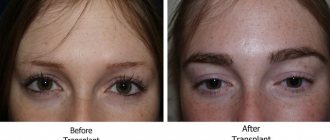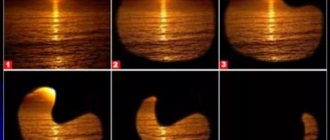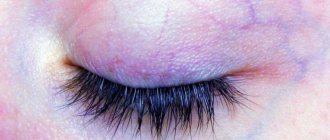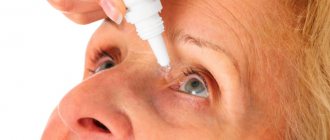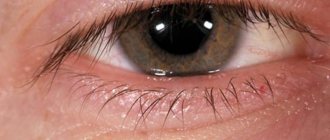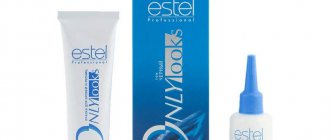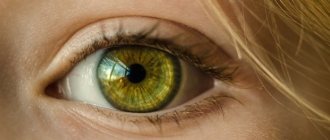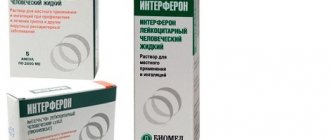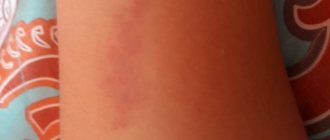Hair, eyebrows and eyelashes are falling out: causes and prevention. Most people perceive thinning hair, eyelashes or eyebrows as very painful. Having discovered lost hairs, many people panic, which is not always justified. There is no need to worry if the number of them per day does not exceed hundreds. Nature has arranged that hair has a certain development cycle, and there comes a time when it naturally dies. A new one grows in its place. The same thing happens with eyelashes. Their lifespan ranges from 2 to 3 months.
Normally, no more than four pieces fall out per day. If there is an excess in the number of hair and eyelashes lost per day, we should talk about pathology, the causes of which may be different.
A small number of lost eyelashes and eyebrows is normal
Why does hair fall out?
In women, the deterioration of the hair condition is often associated with certain changes occurring in the body. The process of hair loss is especially pronounced in the postpartum period. During pregnancy, a large amount of estrogens are produced, which have a beneficial effect on the appearance and growth of hair. During this period, the hair becomes thicker and more voluminous. After the birth of a child, hormonal levels normalize, resulting in severe hair loss. Thinning hair is also observed during menopause. The production of female sex hormones decreases, the concentration of male hormones increases.
Imbalance occurs when taking oral contraceptives, some serious diseases.
Poor nutrition often causes hair loss. Following strict diets and vegetarianism cause a deficiency of nutrients and vitamins in the body, which negatively affects the hair.
Lack of hygiene, when the hair is washed less often than it should, leads to heavier strands. The hair cannot withstand such a load and comes off. Various styling products – mousses, gels, foams – have a similar effect. In addition, they have harmful effects due to the aggressive chemicals included in the composition.
Hair loss is often a consequence of stress.
Problem solving
Internal solution to the problem
The hormonal levels of many women are unstable, which can negatively affect the condition of hair, eyebrows and eyelashes.
To avoid this, you must:
- be less nervous;
- rest more often;
- conduct meditations using aromatic oils;
- improve your diet: consume more dairy products, fresh vegetables, drink plenty of water and take a balanced mineral and vitamin complex.
Vitamins are essential components of a balanced diet
Oil therapy
If the doctor does not find serious violations, you can prepare homemade masks with your own hands and make compresses. The price of such therapy will be much cheaper than the services of beauty salons or beauty salons.
Oil therapy will help eliminate the problem of hair loss. The ingredients in mask recipes are usually taken in equal proportions.
Instructions for preparing masks and their use:
- Add 10 drops of essential oil (lemon, tea tree) to the base of any natural oil (almond, peach, burdock) in the amount of 2 teaspoons. Rub the oil solution into the skin of the eyebrows overnight.
Vegetable oils - healthy eyelashes every day
- Mix crude olive oil and castor oil in equal proportions, add a few drops of aloe juice, apply the resulting mixture to cotton pads and make a compress for 20 minutes.
Masks and compresses are more of a pleasure than a hassle
- A mixture of sea buckthorn oil and liquid retinol will help prevent brittleness. To do this, mix the components 1:1 and apply a compress to the surface of the eyebrows (15 minutes). Then you need to wipe off the residue and moisturize the eyelid skin with cream.
- Squeeze 1 teaspoon of carrot juice and dilute it with a few drops of vitamin E. Apply as a compress to the eyebrows and eyelashes, after 30 minutes rub the remaining mixture into the skin of the eyelid and hairs with your fingertips.
Carrot juice – vitamin compress
- Boil dried figs in high-fat milk, squeeze on gauze and apply to eyelids. Leave for 20 minutes, then rinse with warm water.
- Mash a small piece of banana with a fork and make a mask for the eyelids and eyebrows, which will help strengthen the hair follicles.
Banana mask to nourish and strengthen hair follicles
- For daily care of eyebrows and eyelashes, you can prepare the following mixture: melt 0.5 teaspoon of beeswax, add 0.5 teaspoon of Vaseline and 5 drops of ricin oil. Lubricate eyelids and eyebrows twice a week at night.
It is convenient to apply oils with a brush from under the finished mascara
Causes of eyelash and eyebrow loss
The main cause of hair loss is hormonal imbalance.
They are practically the same as those that cause hair loss - hormonal imbalance, poor nutrition, stress. However, the condition of eyebrows and eyelashes is also influenced by specific factors. They are:
Use of low-quality cosmetics – decorative, caring. Often, women remove mascara and eye shadow using foams and gels that negatively affect eyelashes.
- Neglect of hygiene rules, when cosmetics are left on the face for too long and are not washed off at night. This not only leads to hair loss, but also has a harmful effect on the eyes, irritating the mucous membrane, which can cause vision impairment.
- Eyelash extensions. The use of various adhesive compositions for attaching artificial hairs for this purpose has a harmful effect on natural hairs - they become brittle and ultimately fall out. Not everyone can do extensions. This procedure has a number of contraindications. It is recommended to refrain from using it in the following cases: allergy to resin-based glue; conjunctivitis; weakened eyelashes; oily skin.
- Tattoo. Often the problem of eyelash and eyebrow loss occurs after this procedure. The reasons for this phenomenon are various. One of them is the insufficient qualification of the master. It is better to entrust your face to a specialist with a medical education. First of all, he must inform about contraindications - pregnancy, tendency to scars, bleeding disorders, epilepsy, AIDS and HIV, oncology, diabetes. Antiseptics and pigments used during tattooing can cause an allergic reaction. The technician’s irresponsible attitude towards compliance with sanitary standards required during the procedure becomes the cause of inflammation, which ultimately leads to loss of eyelashes and eyebrows.
In men, a similar problem is usually associated with poor diet, bad habits, eye inflammation caused by sitting for a long time at the monitor, and taking medications.
Eyelash treatment
If the cause of eyelash or hair loss is established, and it is a serious illness, there is no doubt that you need to be cured as soon as possible. And then the eyelashes will begin to renew as usual. But, if the reason is poor-quality cosmetics or a lack of vitamins and microelements necessary for the body, then a number of medical procedures are needed.
- Oil treatment. The oil is applied at night, distributing it along the entire length of the eyelid and eyelashes. During this time, you should stop using mascara, as its components will not allow the oil to work fully.
strength. Castor oil - it is well absorbed, does not thicken, accelerates hair growth and gives it significant strength and elasticity. Burdock oil – contains vitamins A, B, C, mineral salts, iron, calcium, esters, fatty acids. Oil nourishes tissue, restores hair structure, improves eyelash growth. Peach oil is produced from peach seeds. There are two ways to use it: soak a tampon in heated oil and apply it to your eyelids for 10 minutes. Or place the oil in a washed mascara tube and apply it with a brush, this will increase the effect of the procedure. - Herbal compresses. A compress made from cornflower, sage and calendula is considered effective. The collection of herbs is brewed overnight, and in the morning, filtered and made a compress for the eyes using cotton pads for 5-10 minutes. You can add vitamin E to the compress, which is useful for restoring eyelashes and eyebrows.
- Physiotherapy:
- electrophoresis - exposure to direct current with medicinal substances. Under the influence of current, ions of the solution enter the skin and accumulate there, and then disperse throughout the body;
- eyelid massage – accelerates blood flow in the skin, which helps stop eyelash loss;
- magnetotherapy - the use of a magnetic field has long demonstrated its effectiveness for eyelash and hair growth;
- ozone therapy – ozone is administered subcutaneously using special devices. It was found that ozone strengthens the immune system, accelerates metabolism, and promotes nervous relaxation. These functions, together with treatment with compresses and taking vitamins, will not keep you waiting for the effect.
Most popular: Recipes for collagen masks at home
Hormonal reasons
Almost every new mother experiences significant hair loss after childbirth.
Hair loss, which is temporary, stops as soon as the cause that caused the pathological process disappears. Such cases include the postpartum period. It’s another matter when an excessive number of androgens in the body is caused by disturbances in the functioning of the body.
All people have both male and female hormones. Androgens have a negative effect on hair follicles. Estrogens are not able to affect the roots. As a result, female pattern baldness is extremely rare. This occurs when estrogen production decreases and male hormones increase. Baldness in men is greatly influenced by hereditary factors. Therefore, not all representatives of the stronger sex suffer from hair loss.
Baldness manifests itself differently in men and women. In the first, it forms in the form of a separate focus. Female pattern baldness is called diffuse - in this case, hair falls out evenly over the entire surface of the scalp.
Hair loss in children: causes and treatment
So, the main reason why hair loss occurs in infants is their natural structure. Babies may be born with hair, but it is so weak that it falls out without effort. Renewed hair may be different in structure and color. So, for example, a blond person from birth can turn into a brunette, and there is nothing abnormal about this. The core itself is finally formed only by the age of five. Then the hair becomes strong and becomes stiff.
After reading this article, you will learn about hair loss in children, the causes and treatment of this disease. In childhood, alopecia makes itself felt in the same way as in adulthood. The symptoms are the same, and these are hair loss, eyebrows, eyelashes and a slow rate of their regeneration.
At the age of 4-5 years, the child begins the next growth spurt and, accordingly, hair renewal. The hairline is replaced by an “adult” one, and the previous hair simply falls out. This process can occur completely unnoticed, depending on the speed of metabolic processes. A small number of hairs may fall out and be replaced very quickly.
Impact of stress
A person’s health is directly related to the state of his nervous system. In modern dynamic life one cannot do without stress, which becomes another cause of hair loss, deterioration of the condition of eyelashes and eyebrows. Energy resources primarily support vital systems; as a result, peripheral organs suffer from a deficiency of essential substances, which leads to hair loss. Women are especially susceptible to emotional overload.
Stress is one of the causes of hair loss
Why eyelashes don't grow after they fall out
After eliminating the disease that caused hair loss from the eyelids and eyebrows, growth does not resume again. This often happens due to the fact that a person does not eat properly, there is little fortified food in his diet, he is accompanied by stressful situations, he sleeps and rests little. With the normalization of the rest regime, changing the diet and taking vitamins, the situation changes in a positive direction, and the eyelashes begin to grow.
Hair may stop growing if there is a serious eye injury that damages the skin of the eyelids and hair follicles. In this case, transplantation helps.
Eyelashes are needed for beauty and to protect the organs of vision from foreign bodies; they need to be protected and given proper care.
Causes associated with diseases
Deterioration in the appearance of hair, eyelashes, and eyebrows is often caused by existing diseases. The most likely among them are:
- Pathologies of the thyroid gland.
- Anemia.
- Fungal infection. As a result of damage to the skin by pathogenic microorganisms, dandruff is formed. The keratinized cells clog the pores, making it difficult for oxygen to penetrate the follicles and preventing the release of metabolic products. Mycosis and seborrhea contribute to weakening of hair.
- Infectious diseases.
- Disturbances in the digestive system.
What is alopecia and what are its symptoms?
There is no uniform classification of different forms of alopecia. Depending on the causes of the disease, there are: androgenic, symptomatic, seborrheic, premature and alopecia areata. According to the form of hair loss, there are: total (complete absence of hair), diffuse (thinning of hair over the entire surface) and focal (lack of hair in limited areas). The Small Medical Encyclopedia identifies the following forms of this disease: congenital, premature, seborrheic, symptomatic, cicatricial and alopecia areata.
When hair loss is caused by cosmetics
Makeup products applied to the eye area should be selected especially carefully. This area needs careful and caring treatment. Otherwise, eyelash loss may occur. The reasons for this phenomenon may be:
- Poor quality cosmetics. If you notice intense loss of eyelashes after using decorative cosmetics, you need to stop wearing makeup and see a doctor. Expired shampoos have a destructive effect on the lipid layer of the scalp, which causes brittle hair.
- Lack of hygiene. If you don't wash off your makeup before going to bed, you can ruin not only your eyelashes, but also your vision.
If you find any problems that arise after using cosmetics, you should consult a trichologist.
Diseases that cause hair loss
If the owner of thick eyebrows and long eyelashes begins to notice that they are falling out, you should consult a doctor. He will conduct an examination and make a diagnosis. Pathology may be associated with diseases:
- Hypothyroidism and other diseases associated with the thyroid gland. Excess of its hormones leads to thinning of eyelashes, eyebrows and scalp. Other symptoms: depression, dry skin, cramps, constipation.
- Hypovitaminosis. This is one of the common causes of alopecia (baldness). It can develop in people of different sexes. Leads to severe hair loss, regardless of body part.
- Hansen's disease - leprosy - leads to gradual hair loss. The pathology is caused by a bacterial infection that affects the skin on the eyebrows. The disease provokes permanent hair loss. For treatment, doctors prescribe antibiotics for long-term use. The course ranges from six months to 2 years.
- Atopic dermatitis - eczema - leads to thinning of the eyebrow line and loss of eyelashes. The skin becomes inflamed, begins to itch, swells, turns red, and scales appear. The disease often develops in youth, but can also manifest itself in middle age and old age. In advanced cases, the skin becomes dense and tubercles appear. These factors interfere with the natural process of hair renewal.
To get rid of the problem of eyelash loss, you need to consult a dermatologist. He will conduct the necessary research and establish the relevant reasons. At home, you can make compresses to relieve inflammation and apply oil. Doctors prescribe vitamin complexes.
Body hair loss
If you experience hair loss on any part of your body, the first step is to check for a number of skin diseases. A number of skin diseases, the first sign of which is sudden loss of body hair, include:
Hypothyroidism is a thyroid disease in which the amount of hormones produced by the thyroid gland is below normal. With this disease, there is a sharp loss of hair not only on the body, but also on the head. The same can be observed with hyperthyroidism, a disease in which the amount of thyroid hormones is higher than normal. Thyroid diseases are also accompanied by symptoms such as fatigue, irritability, sleep disturbances, and sudden changes in weight. In principle, a thyroid examination should be done at least once a year. With proper timely treatment of hypo- or hyperthyroidism, lost hair, as a rule, grows back.
Lack of dehydroepiandrosterone (adrenal androgen), the most important hormone contained in human blood. This hormone is involved in building muscles and is responsible for their strength and endurance. Its deficiency can also lead to rapid hair loss on the body. Accompanied by decreased libido and muscle weakness. A decrease in the level of this hormone in the blood can be caused by age-related changes, taking antifungal and contraceptive medications, stress, etc. Immediately get tested to check the level of dehydroepiandrosterone and begin treatment.
Treatment of alopecia
cicatricial alopecia, caused by the fact that in the scar tissue that replaces the skin after burns, injuries and skin diseases, hair follicles are completely absent;
non-scarring alopecia (diagnosed in 80-95% of cases) is a disease in which hair follicles are preserved, but for some reason they die or do not develop properly.
Types of non-scarring alopecia:
- symptomatic;
- toxic;
- seborrheic;
- androgenic;
- congenital;
- natural (age-related).
diffuse alopecia – intense but uniform hair loss over the entire area of the scalp (possibly on the body);
localized (focal, circular) alopecia – hair loss in individual areas, which can be of different shapes and sizes;
total alopecia is a complete loss of hair on the head, which is caused by neglected cases of hair loss that did not receive timely treatment.
In case of increased hair loss, first of all you should consult a trichologist, who will decide what exactly: a comprehensive study of the condition of the hair, computer diagnostics, and possibly a biopsy of the scalp, and a special blood test should be done to determine the type of alopecia and the degree damage to hair follicles.
If the information collected is not enough, the patient will have to undergo an examination of the whole body and visit a number of specialists. After the diagnosis has been established, treatment of alopecia begins using individually selected techniques aimed at eliminating the causes of hair loss. Typically used:
- Drug therapy. To treat all types of alopecia, immunomodulators, nootropic (neurometabolic stimulants) and psychotropic drugs, as well as vitamin and mineral complexes are used. If a patient is diagnosed with a nesting form of alopecia, then he is prescribed drugs that improve metabolism and blood microcirculation in the area of increased hair loss, and if we are talking about the treatment of androgenic alopecia in women, then hormonal drugs will be prescribed. In severe cases, corticosteroid therapy is prescribed, which is effective, for example, in the seborrheic form of the disease.
- Physiotherapeutic techniques. In parallel with drug treatment of alopecia, healing and strengthening physiotherapeutic procedures are carried out, such as treatment of the scalp with Darsonval currents, phototherapy and ozone therapy. One of the most effective methods that really helps stop hair loss is mesotherapy, that is, the injection of special cocktails that have a beneficial effect on the condition of the follicles and hair shafts.
Timely treatment can eliminate the consequences of the disease and restore hair by activating “dormant” follicles. If treatment is unsuccessful, a hair transplant operation or transplantation of healthy hair follicles taken from the patient himself in areas of the head (for example, on the back of the head) or body that are not affected by the disease will help.
What is most upsetting is the disastrous result of treatment for alopecia in women, because many representatives of the fair sex are frightened by the prospect of wearing a wig all their lives. However, a correctly selected, high-quality wig product (by the way, it can be not only a wig, but also a hairpiece or hairpiece) can in many cases relieve mental torment.
If treatment for alopecia in a man does not produce a positive result, and hair transplant surgery is excluded, then it is better for him to accept the situation and not try to cover his bald spot with the remaining strands. There are many examples around when a completely bare skull not only does not spoil a person’s appearance, but, on the contrary, gives him a special chic and emphasizes the masculinity of the image.
In recent years, there has been a fashion for getting tattoos on the head. Moreover, we are not talking about shocking images, but about applying pinpoint injections that imitate growing hair. This technique is actively used on the scalp, as well as to restore the eyebrow line and give clarity to the eyelash edge.
Pathological hair loss, leading to severe thinning, and in some places to complete disappearance, is called alopecia. This disease is divided into several types, differing from each other in causes, pattern of the disease, and type of baldness. The most common and most difficult to treat is androgenetic alopecia.
Symptoms
Male and female androgenetic alopecia have completely different symptoms. In men, the strands first become thin and weak, and then begin to fall out intensively on the parietal or frontal area of the head.
We invite you to familiarize yourself with: Types of hair growth stimulants and everything about their use
In women, the first symptoms of the disease appear in the parting area. First, hair loss is observed near the parting, and then the disease gradually spreads over the entire surface of the head. Female androgenetic alopecia usually appears between the ages of 40 and 50, and hair loss occurs diffusely. The pathology does not involve the front part of the hair, and it is very rare that hair loss affects the temples.
Different systems are used to diagnose symptoms and determine the severity of androgenetic alopecia for men and women.
Even with timely and correct diagnosis of alopecia areata, you should not hope that new hair will grow quickly. The process of getting rid of bald spots requires patience and some effort. Doctors advise patients not to despair and to believe in optimistic results.
Alopecia areata is curable, although with great difficulty. Even if it is caused by genetics, you can partially stop baldness, influence the duration of periods of remission for the better, and give your hair a beautiful, well-groomed look.
Medicines
During the treatment of alopecia areata, it is not superfluous to take multivitamin preparations. Antihistamine tablets or drops, antiviral and immunomodulators, as well as agents that accelerate hair growth will also be beneficial. If corticosteroid therapy is required, then when choosing them it is better to listen to the doctor’s opinion and strictly follow all recommendations.
To combat alopecia areata, your doctor may prescribe the following medications:
- Beloderm. Contains betamethasone. Available in the forms of cream, ointment, spray. Cost - from 130 rubles.
- Diprospan. Ampoules with a suspension whose active ingredient is betamethasone. Relieves inflammation and has an antiallergic effect. For focal alopecia, the drug is administered subcutaneously. The price of 1 ampoule is about 220 rubles.
- Isoprinosine. Immunostimulant with antiviral effect. Available in tablets of 20, 30 and 50 pieces, price - from 600 to 1300 rubles.
- Cutivate. The cream relieves inflammation and has an antiallergic effect. You can purchase it at a price of 330 rubles.
- Sandimmune-Neoral. Belongs to the category of immunosuppressants - drugs that artificially suppress the immune system. For focal alopecia, it is useful because it weakens autoimmune processes (if they are diagnosed, of course). As a result, follicles are not perceived as foreign bodies that need to be dealt with. Hair doesn't fall out. The product is available in capsules of 50 pieces (there are different dosages: 25, 50 and 100 milligrams), as well as in the form of bottles with an oral solution. Cost - from 1100 to 5100 rubles.
- Finasteride. Contains special hormones, so it can be used for alopecia areata exclusively in men. The price of 30 tablets starts from 200 rubles and depends on the manufacturer (domestic or imported).
- Celestoderm B. The hormonal product can be purchased in the form of an ointment or cream. Cost - from 230 rubles.
For focal alopecia, it is useful to use Dimexide and preparations with minoxidil. All this will speed up hair growth.
Traditional methods
Home recipes are a good help in the treatment of alopecia areata, but only if they are not used independently and in isolation from medications. Traditional methods will help activate hair regrowth, awaken hair follicles, improve the structure of strands and strengthen them. Such help is indispensable in a situation where the causes of alopecia areata have been diagnosed, therapy has been prescribed and it is necessary to further stimulate the overgrowth of bald spots with new hairs.
Try to eliminate the symptoms of alopecia areata with the following home remedies:
- Pepper tincture. Improves blood supply to the scalp and nutrition of the bulbs. To prepare, chop a large red pod and pour 100 grams of vodka into it. Place in a dark and cool place. After a day, the tincture is ready for hair treatment. Rub it into areas affected by alopecia areata twice a day.
- Nettle rinse. Pour 2-3 tablespoons of dry herb into a liter of water. Place on low heat and after boiling, keep on the stove for 7-10 minutes. To strengthen your hair, rinse your hair every other day.
- A decoction of coltsfoot. It is brewed almost the same way as nettle rinse. Only the boiling time over low heat should be reduced to 5–7 minutes. Wash or rinse your hair with the product. The course of treatment is a month. During this period, the hair should become much stronger.
- Ginger tincture. To quickly overcome the effects of alopecia areata and stimulate healthy hair growth, mix 2 ingredients: chopped ginger (a little more than half of the medium root) and a glass of vodka. Cover tightly and store in a dark, cool place for 14 days. Shake the container regularly. Moisturize the areas affected by alopecia areata with the finished tincture, while simultaneously doing a gentle massage with your fingertips.
- Infusion of hop cones. Preparing it couldn’t be easier: pour 100 grams of raw materials with a liter of boiling water. Wrap and leave for 15–20 minutes. Rub into areas where hair has gone bald due to alopecia areata or rinse hair after washing.
- Burdock ointment. 20 grams of burdock root (dry or fresh) should be poured with 200 milliliters of water and put on fire. When the volume of the contents is reduced by half, add 1 tablespoon of pork fat to it and cover the container with a lid. You can remove it from the heat after the fat has melted. In the fight against alopecia areata, it is necessary to treat the areas where hair has fallen off with this ointment 3-4 times a day.
- Egg-oil mask. Combine chicken yolk with a tablespoon of olive oil. Mix well and rub into scalp. There is no need to warm your hair. The mixture is washed off after half an hour, and the procedure is repeated once a week.
